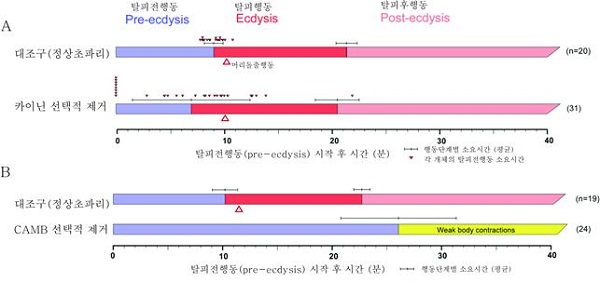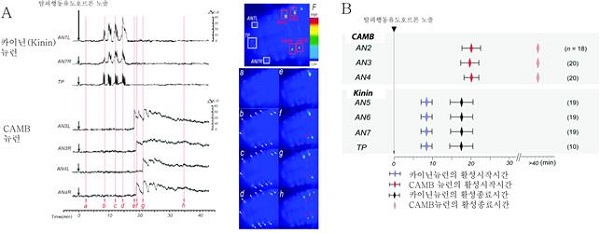Media Center
A multimedia mosaic of moments at GIST
GIST Excellence
[Press Release] Professor Young-Joon Kim"s research team has identified ecdysial behavior control mechanisms in Drosophila
- 엘리스 리
- REG_DATE : 2015.10.19
- HIT : 704
Ecdysial behavior control mechanisms identified in Drosophila
Two groups of central ecdysis triggering hormones (ETH) receptor neurons are implicated in the first two steps of initiating ecdysial behavior, which may lead to the development of entirely new methods to control harmful pests and insects

GIST Professor Young-Joon Kim (left) and Dr. Do-Hyoung Kim from KAIST (right)
have published their research in PLos Genetics.
have published their research in PLos Genetics.
□ GIST (Gwangju Institute of Science and Technology) researchers with the collaboration of American scientists have succeeded in identifying the work-cycle of the neurons involved in ecdysis, which is the instinctive molting behavior of insects. This discovery may help contribute to the development of entirely new categories of pesticides and methods of pest control.
* Ecdysial behavior: Insects are arthropods that must molt their exoskeleton to grow. If insects are not able to molt, then they will not survive. Understanding the ecdysial behavior control mechanism may contribute to the development of new categories of pesticides that inhibit specific insect molting processes.
∘ This research was conducted by GIST Professor Young-Joon Kim (co-corresponding author) of the Department of Life Science, Professor Michael Adams (co-corresponding author) University of California, Riverside, and Dr. Do-Hyoung Kim (first author, postdoctoral researcher at the University of California, Riverside) of the Korea Advanced Institute of Science and Technology (KAIST). The study was sponsored by a National Research Foundation of Korea grant funded by Ministry of Science, ICT and Future Planning, a "Cooperative Research Program for Agriculture Science & Technology Development" grant funded by the Rural Development Administration of Korea, and the "Basic Research Projects in High-tech Industrial Technology" Project through a grant provided by GIST in 2015. The research was published in the highly-regarded online academic journal PLoS Genetics on September 24, 2015.
* Paper title: Rescheduling Behavioral Subunits of a Fixed Action Pattern by Genetic Manipulation of Peptidergic Signaling
□ Ecdysis triggering hormones (ETH) initiate the instinctive molting behavior of most insects and arthropods. Understanding how these hormones can control the fixed action pattern of insects is an important step in understanding their behavior.
∘ Ecdysis triggering hormones (ETH) act directly upon the central nervous system by interacting with two groups of receptor neurons: kinin and CAMB. Although it was not well understood how a single hormone can regulate a complex cascading behavioral sequence, the researchers presented evidence that implicates the prominent roles of the kinin and CAMB in ecdysis.

(Figure 1) Figure 1 shows the ecdysial behavior change through selective elimination of specific neurons ensembles during three specific steps: pre-ecdysis, ecdysis, and post-ecdysis.
□ The researchers found that ecdysis in Drosophila is activated through two groups of ETH receptor neurons (kinin neurons and CAMB neurons*), which have critical roles in scheduling the successive steps involved in ecdysis.
* CAMB neurons secrete all four of the hormones CCAP, AstCC, MIP, and Bursicon).
∘ Kinin neurons regulate pre-ecdysial behavior, and CAMB neurons initiate the switch to ecdysial behavior. The timing of the switch is also influenced by G-protein signaling. Overexpression of Gαq in CCAP neurons greatly accelerated the timing of the switch to ecdysis whereas overexpression of Gαq in kinin neurons increased the timing to ecdysis onset. These findings offer solid evidence that Gαo signaling helps to determine the timing of the ecdysis switch.

(Figure 2) Figure 2 confirms the active phase of the kinin neurons and CAMB neurons by using a calcium imaging techniques, which shows the relative differences of activated kinin neurons and CAMB neurons when exposed to ETH.
□ GIST Professor Young-Joon Kim said, "This research presents a new theory to explain how instinctive fixed action patterns such as ecdysis occurs in insects like Drosophila. Having a better understanding of the underlying principles that regulate the ecdysial process may lead to the development of new and innovative methods of pest control."